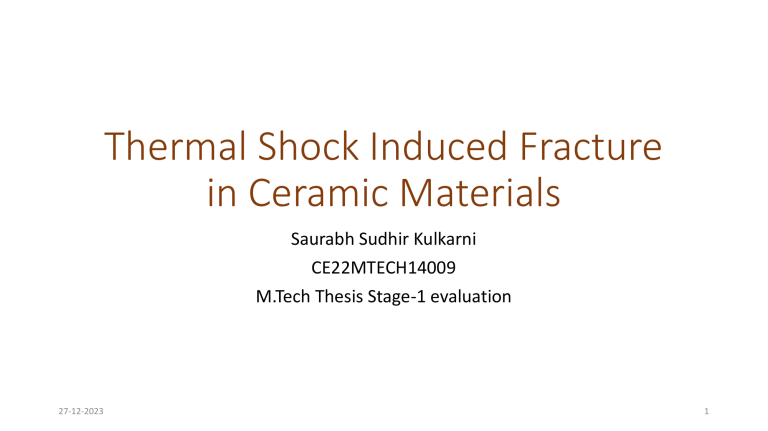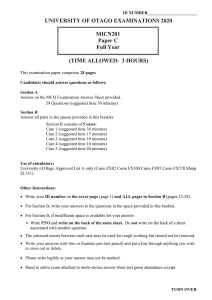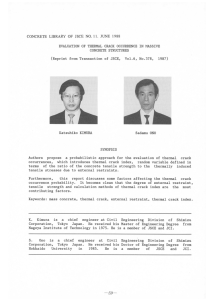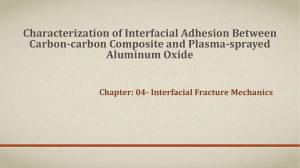
Thermal Shock Induced Fracture in Ceramic Materials Saurabh Sudhir Kulkarni CE22MTECH14009 M.Tech Thesis Stage-1 evaluation 27-12-2023 1 Contents • Introduction • Literature Review • Motivation • Objectives • Formulation • Results • Tasks Ahead 27-12-2023 2 Introduction Ceramics • ‘Keramikos’ ‘for pottery • Inorganic, metallic oxides, carbides or nitride materials. • High hardness, high temperature resistance, high wear resistance, high corrosion resistance and lower density but also brittleness. • Applications in aerospace and defence industry at extreme conditions such as thermal shock. Thermal shock • Rapid change in temperature that results in very high heat fluxes and transient mechanical load on the structure. 27-12-2023 3 Introduction • Investigation of thermal-shock induced fracture behaviour of ceramics through experiments , analytical models and numerical simulations • Critical thermal stress theory based on thermoelasticity • Thermal shock damage theory based on fracture mechanics • Predicting critical thermal shock temperature difference • Experimental Multi crack propagation with periodic and hierarchical characteristics in brittle and thin strips through simulating the thermal shock by water quenching • Numerical Behaviour of ceramics subjected to thermal shock through damage mechanics model in the frame of finite element method, peridynamic model and phase field methods 27-12-2023 Ref. Simulation of crack patterns in quasi-brittle materials under thermal shock using 4 phase field and cohesive zone models Introduction • Various methods : Cohesive zone modelling, Extended finite element method, Meshfree methods, Peridynamics, Cracking particle method, Screened poisson equation, Scaled boundary finite element method, Generalised finite element method and Phase field method. • Phase field method is used in this work as it is superior to other methods in following aspects 1. It can naturally handle complex crack patterns and phenomena like crack branching and coalescence without the need to explicitly track the crack surface. 2. The method can be used for intrinsic fracture nucleation and propagation. 3. This method can also be coupled with other methods such as cohesive zone modelling and extended FEM. 4. The method can be extended to 3D problems without major difficulty 27-12-2023 5 1. Experiments and numerical simulations of thermal shock crack patterns in thin circular ceramic specimens Authors – Liu Y., Wu X., Guo Q., Jiang C., et al. Year - (2015) • Observation of periodical cracks development through experimental study on water quenching of thin circular alumina specimens • Observation that the higher the temperature, the more the cracks. • The long cracks become longer, and the short cracks become shorter as initial temperature increases. • The two stability criteria of crack propagation, i.e. the minimum potential energy principle and the fracture mechanics bifurcation theory are in good agreement with the experimental findings. Crack pattern observed at temperature of 4000c 27-12-2023 Crack pattern observed at temperature of 5000c Temperature vs Spacing 6 2. Numerical model for the cracking behavior of heterogeneous brittle solids subjected to thermal shock Authors - Tanga S.B., Zhanga H., Tanga C.A., H.Y. Liub H.Y. Year - 2016 • Considered the effect of heterogeneity in the material strength by randomly specifying the strength and elastic modulus to the elements which follow Weibull distribution which in turn is obtained by Monte-Carlo simulations. • The greater conductivity results in smaller thermal gradient and significantly reduces the number of cracks initiated on the surface. • The results show that the temperature fluctuates sharply on both sides of the cracks and is significantly different from the temperature field in the intact specimen. 27-12-2023 Results showing disturbed temperature field after evolution of crack Heterogeneity of Elastic Modulus assigned over the domain 7 3. Fracture of thermo-elastic solids: Phase-field modeling and new results with an efficient monolithic solver Authors – Mandal T. K., Nguyen P. B., Wu J. Y. et al. Year - 2021 • Phase-field regularized cohesive zone model (PF-CZM) for thermo-elastic solids has been presented which can model thermally induced fracture for both brittle and quasi brittle formulations. • BFGS (Broyden–Fletcher–Goldfarb–Shanno) scheme to is used solve multi-field discretized scheme for efficiency. • However, the degradation in conductivity with evolution of damage and convective heat transfer is not accounted for in this work. 27-12-2023 Crack pattern observed at temperature of 3000c 8 4. Three-dimensional phase-field modeling of temperature-dependent thermal shockinduced fracture in ceramic materials Authors -Dingyu Li, Peidong Li, Weidong Li, Weiguo Li, Kun Zhou Year -2022 • Thermo-mechanical fracture of alumina specimen subjected to thermal shock is simulated • Inclusion of temperature dependent fracture energy threshold and consideration of water entry posture improved the results significantly. • Crack propagation in 3d specimen also was simulated. • Simulation results revealed the mechanism that the tensile part of the strain energy controlled the initiation and propagation of the thermal shock-induced cracks in ceramics. Crack pattern observed at temperature of 3000C Crack pattern observed at temperature of 5000C Three-Dimensional Model at temperature of 3400C 9 27-12-2023 Motivation • Complicated operational environments such as aerodynamic heating on ceramics can result in tremendous temperature gradient in an instant. • The inherent brittleness of ceramics makes them vulnerable to thermal shock induced fracture which can lead to sudden catastrophic failure of structure. • The analysis of thermal shock induced fracture in ceramics can provide insights into their failure mechanism. 27-12-2023 Ceramic radomes are used to protect missile antenna Alumina samples after water quenching test 10 Motivation • A comprehensive approach considering all relevant factors has been lacking. • Focus on individual aspects such as 1. Water quenching 2. temperature-dependent failure criteria 3. Heterogeneity in material properties Novelty An improved regularization of the crack to accurately model the phenomenon. 27-12-2023 11 Objectives 1.To develop a numerical model to simulate thermal shock induced fracture in ceramic materials. 2. Perform parametric studies on the model by varying parameters such as • Geometry • Magnitude of loading • Material properties 3. Validation of the model with results from the literature 27-12-2023 12 Formulation • Consider an infinite one-dimensional (1D) bar with a cross section Γ and a fully opened crack at x = 0 Sharp Crack • The sharp crack is regularised using d(x) = e−|x|/lc -------- 1 lc = length scale parameter • The width of the diffuse crack region will increase with lc • sharp crack will be recovered as lc 0. Diffused Crack 27-12-2023 13 Formulation • The approximation is solution to equation d(x) − lc2Δd(x) = 0 Dirichlet boundary condition: d(0) = 1 and d(±∞) = 0. • The Galerkin type weak form 1 2 I(d) = ∫Ω( d2 + lcd’2 )dV. • dV = Γdx , I(d = e−|x|/lc) = lcΓ • Fracture surface density per unit volume is given by Γ(d) = 1 1 I(d)= ∫Ω( 𝑙𝑐 2𝑙𝑐 d2 + lcd’2 )dV=∫Ω γ( d, d′ )dV where γ(d, d′ ) is the 1D crack surface density function 27-12-2023 14 Formulation • γ(d, ∇d) = 1 2 d 2𝑙𝑐 + lc|∇d|2 --------------2 • Brittle fracture of thermo-elastic solids is governed by minimizing the free energy L that contains the elastic energy, fracture energy, thermal energy, heat, and external work L = − ∫Ω ψε(εe (u, T))dV − ∫ Γc GcdΓ + ∫Ω( ρCpT˙ + ∇⋅Q − q )dV + ∫ ∂Ωt t⋅udΓ + ∫Ω b⋅udV + ∫∂ΩQQ’⋅ndΓ --------3 Where Q is the heat flux Q’ is denoted as the heat flux at the boundary ∂ΩQ T is the temperature The boundaries for heat transfer and mechanical deformation problems are expressed by ∂Ω =∂ΩQ∪∂ΩT and ∂Ω = ∂Ωt ∪ ∂Ωu t represents the traction vector applied at ∂Ωt q is the internal heat source The inertia is ignored because of its imperceptible effect in thermal shock-induced fracture problems. 27-12-2023 15 Formulation Gc is the critical energy release rate ρ is the density Cp is the specific heat of the material The term ψε(εe(u, T)) is the elastic energy density relied on the linear strain tensor εe(u, T) = ε − εT in which the total strain tensor is ε=(∇u +∇uT)/2 and the thermal strain tensor is εT = αΔTI, where α is thermal expansion coefficient of materials, ΔT is the temperature difference and I is the identity tensor. By introducing crack density function in fracture energy G ∫ΓcGcdΓ = ∫Ω c (d2 + lcd’2 )dV. 2𝑙𝑐 27-12-2023 ------------4 16 Formulation • As a crack does not propagate under compression, the strain energy density that drives the crack propagation should be decomposed into tensile and compressive parts. • A degradation function g(d) is introduced into the positive part of the strain energy density to characterize the effect of the phase-field crack on material properties. • Therefore, the strain energy density has the form ψε(εe (u, T), d ) = g(d)ψ+ε(εe ) + ψ−ε (εe ) Where g(d) =(1−d)4 + δ 27-12-2023 17 Formulation Strong Form • divσ + ρb = 0 in Ω, • ρCpT˙ + ∇ ⋅ Q = q in Ω, • Gclc(d−lc2Δd ) = g’ (d) ψ+ε in Ω, • σ ⋅ n = t on ∂Ωt, • Q ⋅ n = Q on ∂ΩQ , • ∇d ⋅ n = 0 on ∂Γc. With initial conditions T(x, t) = T0(x, 0) in Ω, u(x, t) = u0(x, 0) in Ω, d(x, t) = d0(x, 0) in Ω 27-12-2023 ----------- 5a ----------- 5b ------------ 5c ------------ 6a ------------ 6b ------------- 6c 18 Formulation • According to Eq. 6c, the phase-field variable d will evolve if ψe+> 0, even if ψe+ has a very small value • Therefore, fracture energy is modified as ∫ΓcGcdΓ =∫Ω[1 − g(d)]ψc + ψc( d2 + lc2|∇d|2 )dV Where ψc is critical fracture energy threshold Temperature dependent fracture energy threshold can be given as ∫0TCp(T)dT ψc(T) = ψc (T0) [ 1 − Tm ] ∫0 Cp(T)dT 27-12-2023 19 Formulation Weak Form • ∫Ω ρCpT˙δTdV − ∫ΩQ ⋅ ∇(δT)dV − ∫Ω qδTdV + ∫∂ΩQ QδTdΓ = 0 • ∫Ω σ : δεdV + ∫∂Ωt t ⋅ δudΓ + ∫Ω b ⋅ δudV = 0, • ∫Ω g’ (d)HeδddV + ∫Ω2ψc ( dδd − lc2∇d∇(δd) )dV = 0 where He(u(x,s), T) = max s∈[0,t] 〈 ψe+(u(x,s),T) − ψc 〉 δT, δu and δd are the variational test functions. Due to weak coupling effects and high calculation efficiency the equations are solved in staggered manner . 27-12-2023 20 Formulation Approximation with FEM shape functions T = ∑nI=1 NTi Ti u = ∑nI=1 Nui ui d = ∑nI=1 Ndi di Gradients of the field variables can be given by using geometry matrices as ∇T = ∑nI=1 BTi Ti ε = ∑nI=1 Bui ui ∇d = ∑n I=1 Bdi di 27-12-2023 21 Formulation Residuals can be obtained as RTi = ∫Ω ρCpT˙NTI dV − ∫ΩQ BTI dV − ∫Ω qNTI dV + ∫∂ΩQ QNTI dA Rui = ∫ΩσBuIdV - ∫∂Ωt tNuIdΓ - ∫ΩbNuIdV Rdi = ∫Ω2ψclc2BdI∇ddV + ∫Ω2NdI [ ψcd − 2(1 − d)3He ]dV Corresponding tangent matrices can be obtained as ∂RTi KTij= = ∫Ω ρCpΔt( NTi )TNTj dV + ∫Ω (1 − d)4 k( BTi )TBTjdV ∂T𝑗 ∂R Kuij = ui = ∫Ω[(1 − d)4 + δ ]( Bui )TD0BujdV ∂𝑢𝑗 ∂R Kdij = di = ∫Ω 2ψclc2( Bdi )T BdjdV + ∫Ω2( Ndi )TNdj[ ψc + 6(1 − d)2He ] dV ∂𝑑𝑗 27-12-2023 22 Problem Statement • A 1mm*1mm thin plate with unit thickness subjected to Dirichlet Boundary condition of T=288K on all the boundaries following initial conditions. T=288 K T(x, 0) = 773K in Ω u(x, 0) = 0 in Ω d(x, 0) = 0 in Ω. T=288 K T0=773K uo=0 do=o T=288 K T=288 K 27-12-2023 23 Input parameters used in analysis • Density = 3.95 g/cc; • Heat capacity = 764e-3; • Thermal conductivity = 36; • Heat transfer coefficient = 0.04; • Coefficient of thermal expansion =5e-6; • Young’s Modulus = 378000 N/mm2; • Poisson’s ratio = 0.22; • Critical Fracture Energy Threshold = 0.1397; • Element type – Linear Quadrilateral; • Element size – 0.01mm; 27-12-2023 Mesh used in the analysis 24 Results Temperature distribution when Dirichlet Boundary condition of 288k and initial condition of 773k was 27-12-2023 applied. When initial cracks were introduced at midpoints of boundaries and Dirichlet boundary condition of 600 k was applied 25 Tasks Ahead • Improve the accuracy of model by introducing convection at the boundaries. • Improve the accuracy by changing the regularisation of the crack. • Introduce heterogeneity for better accuracy. 27-12-2023 26 Thank You 27-12-2023 27






